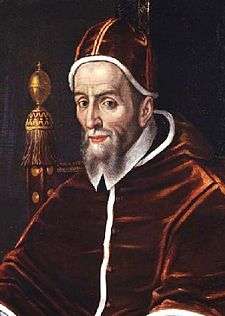Pope Urban VII
Pope Urban VII (Latin: Urbanus VII; 4 August 1521 – 27 September 1590), born Giovanni Battista Castagna, was head of the Catholic Church and ruler of the Papal States from 15 to 27 September 1590. His twelve-day papacy was the shortest in history.
Pope Urban VII | |
|---|---|
| Bishop of Rome | |
 | |
| Papacy began | 15 September 1590 |
| Papacy ended | 27 September 1590 |
| Predecessor | Sixtus V |
| Successor | Gregory XIV |
| Orders | |
| Ordination | 30 March 1553 by Filippo Archinto |
| Consecration | 4 April 1553 by Girolamo Verallo |
| Created cardinal | 12 December 1583 by Pope Gregory XIII |
| Personal details | |
| Birth name | Giovanni Battista Castagna |
| Born | 4 August 1521 Rome, Papal States |
| Died | 27 September 1590 (aged 69) Rome, Papal States |
| Previous post | |
| Coat of arms | |
| Other popes named Urban | |
| Papal styles of Pope Urban VII | |
|---|---|
 | |
| Reference style | His Holiness |
| Spoken style | Your Holiness |
| Religious style | Holy Father |
| Posthumous style | None |
Biography
Early life
Giovanni Battista Castagna was born in Rome in 1521 to a noble family as the son of Cosimo Castagna of Genoa and Costanza Ricci Giacobazzi of Rome.[1]
Castagna studied in universities all across Italy and obtained a doctorate in civil law and canon law when he finished his studies at the University of Bologna. Soon after he became auditor of his uncle, Cardinal Girolamo Verallo, whom he accompanied as datary on a papal legation to France.[1] He served as a constitutional lawyer and entered the Roman Curia during the pontificate of Pope Julius III as the Referendary of the Apostolic Signatura. Castagna was chosen to be the new Archbishop of Rossano on 1 March 1553, and he would quickly receive all the minor and major orders culminating in his ordination to the priesthood on 30 March 1553 in Rome. He then received episcopal consecration a month after at the home of Cardinal Verallo.
He served as the Governor of Fano from 1555 to 1559 and later served as the Governor of Perugia and Umbria from 1559 to 1560. During the reign of Pius IV he settled satisfactorily a long-standing boundary dispute between the inhabitants of Terni and Spoleto.[1] Castagna would later participate in the Council of Trent from 1562 to 1563 and served as the president of several conciliar congregations. He was appointed as the Apostolic Nuncio to Spain in 1565 and served there until 1572, resigning his post from his archdiocese a year later. He also served as the Governor of Bologna from 1576 to 1577. Among other positions, he was the Apostolic Nuncio to Venice from 1573 to 1577 and served also as the Papal Legate to Flanders and Cologne from 1578 to 1580.
Pope Gregory XIII elevated him to the cardinalate on 12 December 1583 and he was appointed as the Cardinal-Priest of San Marcello.
Papacy
Election
After the death of Pope Sixtus V a conclave was convoked to elect a successor. Ferdinando I de' Medici, Grand Duke of Tuscany had been appointed a cardinal at the age of fourteen, but was never ordained to the priesthood. At the age of thirty-eight, he resigned the cardinalate upon the death of his older brother, Francesco in 1587, in order to succeed to the title. (There were suspicions that Francisco and his wife died of arsenic poisoning after having dined at Fernando's Villa Medici, although one story has Fernando as the intended target of his sister-in-law.) Ferdinando's foreign policy attempted to free Tuscany from Spanish domination. He was consequently opposed to the election of any candidate supported by Spain. He persuaded Cardinal Alessandro Peretti di Montalto, grand-nephew of Sixtus V to switch his support from Cardinal Marco Antonio Colonna, which brought the support of the younger cardinals appointed by the late Sixtus.[2]
Castagna, a seasoned diplomat of moderation and proven rectitude was elected as pope on 15 September 1590 and selected the pontifical name of "Urban VII".[2]
Activities
Urban VII's short passage in office gave rise to the world's first known public smoking ban, as he threatened to excommunicate anyone who "took tobacco in the porchway of or inside a church, whether it be by chewing it, smoking it with a pipe or sniffing it in powdered form through the nose".[3]
Urban VII was known for his charity to the poor. He subsidized Roman bakers so they could sell bread under cost, and restricted the spending on luxury items for members of his court. He also subsidized public works projects throughout the Papal States. Urban VII was strictly against nepotism and he forbade it within the Roman Curia.[4]
Death
Urban VII died on 27 September 1590, shortly before midnight, of malaria in Rome. He was buried in the Vatican. The funeral oration was delivered by Pompeo Ugonio. His remains were later transferred to the church of Santa Maria sopra Minerva on 21 September 1606.
His estate was valued at 30,000 scudi and it was bequeathed to the Archconfraternity of the Annunciation to use as dowries for poor young girls.
SIC•LUCEAT•LUX•VESTRA
(Let your light so shine - Matt. 5:16)
See also
References
- Ott, Michael. "Pope Urban VII." The Catholic Encyclopedia Vol. 15. New York: Robert Appleton Company, 1912. 20 December 2018

- Pirie, Valérie Pirie. The Triple Crown: An Account of the Papal Conclaves, London. Sidgwick & Jackson, 1935
- "Public smoking ban: Europe on the move" (PDF). European Society of Cardiology. 2006. Archived from the original (PDF) on 24 May 2011.
- "Pope Urban VII". Saints SQPN. 4 April 2012. Retrieved 12 February 2015.
External links

| Catholic Church titles | ||
|---|---|---|
| Preceded by Sixtus V |
Pope 15–27 September 1590 |
Succeeded by Gregory XIV |